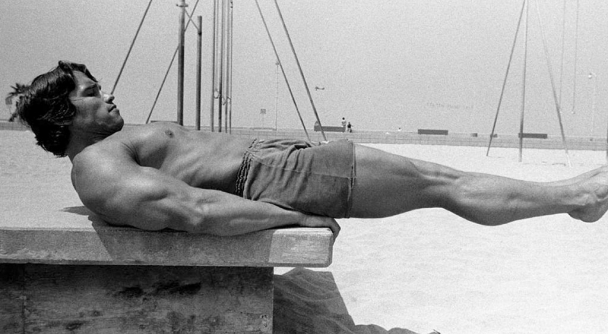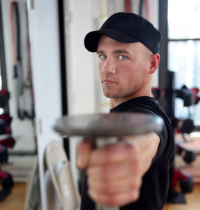Exercise & Carbs: A Game-Changer


By Rob Sulaver
A few weeks ago we talked about why we get fat. In case you missed it, here’s a summary:
Carbs.
Yep. It’s that simple. Okay, that’s a lie. It’s not that simple. It’s nowhere near that simple. However, it is clear that managing our carbohydrate intake goes a long way to help manage our fat accumulation. We, as Americans, need to consume fewer carbs if we want to get our body fat percentage to shredded status.
But there’s one time of day when our relationship to carbohydrates completely changes.
Enter exercise.
We’ve all heard about the importance of exercise when it comes to weight-management. You gotta do it. It’s essential. The body needs it. But most of us tend to think of exercise as cranking up calorie burn. We return to our calories-in-calories-out equation and think that exercise amps up the out-calories and therefore we lose weight. This is absolutely true. Exercise does help balance the calorie math in favor of leanness. However, when we work out there are far more magical things at play.
Why is exercise a game-changer when it comes to carbs?
Most of the day, our energy fluxes are moderated by insulin. A quick reminder of our bilingual equation:
Más carbs = Más blood sugar.
Más blood sugar = Más insulin.
Más insulin = Más fat storage.
However, during intense exercise the body doesn’t give a damn about insulin. In fact, despite a significant increase in our need for energy (and specifically glucose), insulin actually decreases (1).
WHOA, WHOA, WHOA. W.T.F.
But Rob...insulin is the hormone that tells our body to remove sugar from the blood and use it as energy.
Yep. Except during intense exercise.
Allow me to formally introduce you to catecholamines.
Catecholamines are hormones that are produced by the adrenal glands. You’ve probably heard of the more famous ones - adrenaline (epinephrine), noradrenaline (norepinephrine), and dopamine.
Catecholamines are released during our primitive fight-or-flight response, but the physiological response during intense exercise is similar (and I do mean intense - a long slow jog isn’t going to make this magic happen - you’ve gotta be working at an 8ish outta 10 on your damn-this-is-tough scale.) When that happens, our body dumps these hormones into our system and they trump our insulin command.
The games has changed. We now have a completely difference coach. Catecholamines are at the helm calling the shots, regulating our energy influx and outflux with extreme precision. It’s awesome.
- We’re working our little tooshes off
- We’re burning a boat-load of calories
- These calories aren’t being regulated by our insulin levels
This is good news because it means we don’t need to carb up before an intense workout. In fact, carbing up an hour before a workout has been shown to reduce liver glucose output and fat oxidation (2) (3). No bueno if we’re trying to get lean.
But other, even MORE magical things are happening...
Allow me to formally introduce you to Lipoprotein Lipoase.
Simultaneously, during all this good stuff, during this exercise our body starts to shift a little enzyme called Lipoprotein Lipase (LPL.) These little fellas are the gatekeeper for fat accumulation. It’s an enzyme that hangs out outside cells, sorta like a bouncer. If it’s hanging out outside a muscle cell, it’ll pull fat into the muscle. If it’s hanging out outside of a fat cell, it’ll pull fat into the, um, fat. (4)
So, intense exercise shifts LPL activity from fat cells to muscles cells. In other words, our muscles become primed to burn fat. Now to be fair, we don’t burn a whole lot of fat during high intensity exercise. We burn carbs. But, as you can probably imagine, shifting this fat crushing enzyme to our muscles and away from our fat makes a big difference when it comes to helping us get shredded.
OK. Let’s summarize again...
- We’re working our little tooshes off
- We’re burning a boat-load of calories
- These calories aren’t being regulated by our insulin levels
- We shift our muscles into fat burning mode
- We shift our fat away from fat storing mode
For the record...at this point, we’re definitely winning.
OKAY, OKAY...WHAT HAPPENS NEXT, ROB?
Well then....we stop. ‘Cause hey...you can’t do high intensity exercise forever, right?
Now....
The catecholamines disappear (the half life of these suckers is a few minutes, max.) Insulin becomes the driving force behind our energy flux again. Our muscles are hungry and want to be fed whatever they can eat and our fat storage is basically turned off (4).
What’s a lovely thing to do at this point??
Feed your body carbs.
Yep. Your body is in a perfect place to utilize carbs. You feed those hungry muscles without storing energy as fat. An influx of carbs will spike your insulin which will drive glycogen into your muscles and get you all prepped for your next intense workout. Plus, this carb/insulin spike helps with a cascade effect that returns your hormones to their happy pre-workout state, because while all those higher-stress hormones are great when you’re working out, you don’t want ‘em in your system all day. Ya dig?
Eating carbs post workout is part of a smart get-shredded nutrition plan.
A qualifier - this post workout carb window doesn’t last the rest of the day. It lasts for about an hour. After that, we start to lose out on the benefits of the carbohydrate awesomesauce.
Another qualifier - The more depleted your muscles, ie the more intense your workout, the more carbs you can afford post workout. Makes sense right...the more you lose, the more you can replenish.
A summary. If you want to get lean, avoiding carbs most of the day helps (except for veggies, of course...always eat veggies.) But after an intense workout, eating carbs will manage your hormone profile, feed hungry muscles without getting stored as fat, and make you feel swell.
Win, win, win (again).
If we get 75 comments on this bad boy, I’ll give you my favorite post-workout carb/protein shake recipe. It’s so delicious, it’s been known to make grown men cry. I’m not joking. In fact, my post-workout carb/protein shake brings all the boys to the yard.
Ugh....I’m sorry I just said that.
- Galbo H: Hormonal and Metabolic Adaptation to Exercise. New York, Thieme-Stratton, 1983
- Volek JS. Influence of nutrition on responses to resistance training. Med Scho Sports Exerc 2004;36(4):689-696.
- Ivy JL, Res PT, Sprague RC, Widzer MO. Effect of ca carbohydrate-protein supplement on endurance performance during exercsie of varying intesnity. Int. J Sports Nutr Exerc Metab 2003;13:382-295.
- Ladu MJ, Kapsas H, Palmer WK. Regulation of lipoprotein lipase in muscle and adipose tissue during exercise. J Appl Physiol. 1991 Aug;71(2):404-9.
- Mead JR, Irvine SA, Ramji DP. Lipoprotein lipase: structure, function, regulation, and role in disease. J Mol Med (Berl). 2002 Dec;80(12):753-69. Epub 2002 Oct 24.
ABOUT THE AUTHOR

Writer, trainer, coach, sports nutritionist and fitness ninja rockstar Rob Sulaver owns and operates Bandana Training. He dishes out fitness, nutrition, and lifestyle advice with a dash of awesomesauce and glass of ass-kick juice. Rob enjoys strong things like tanks, front squats, and fast twitch muscle fibers. He also loves to cuddle.
Website: http://www.bandanatraining.com/
Facebook: https://www.facebook.com/BANDANATRAINING
Twitter: https://twitter.com/bandanatraining
